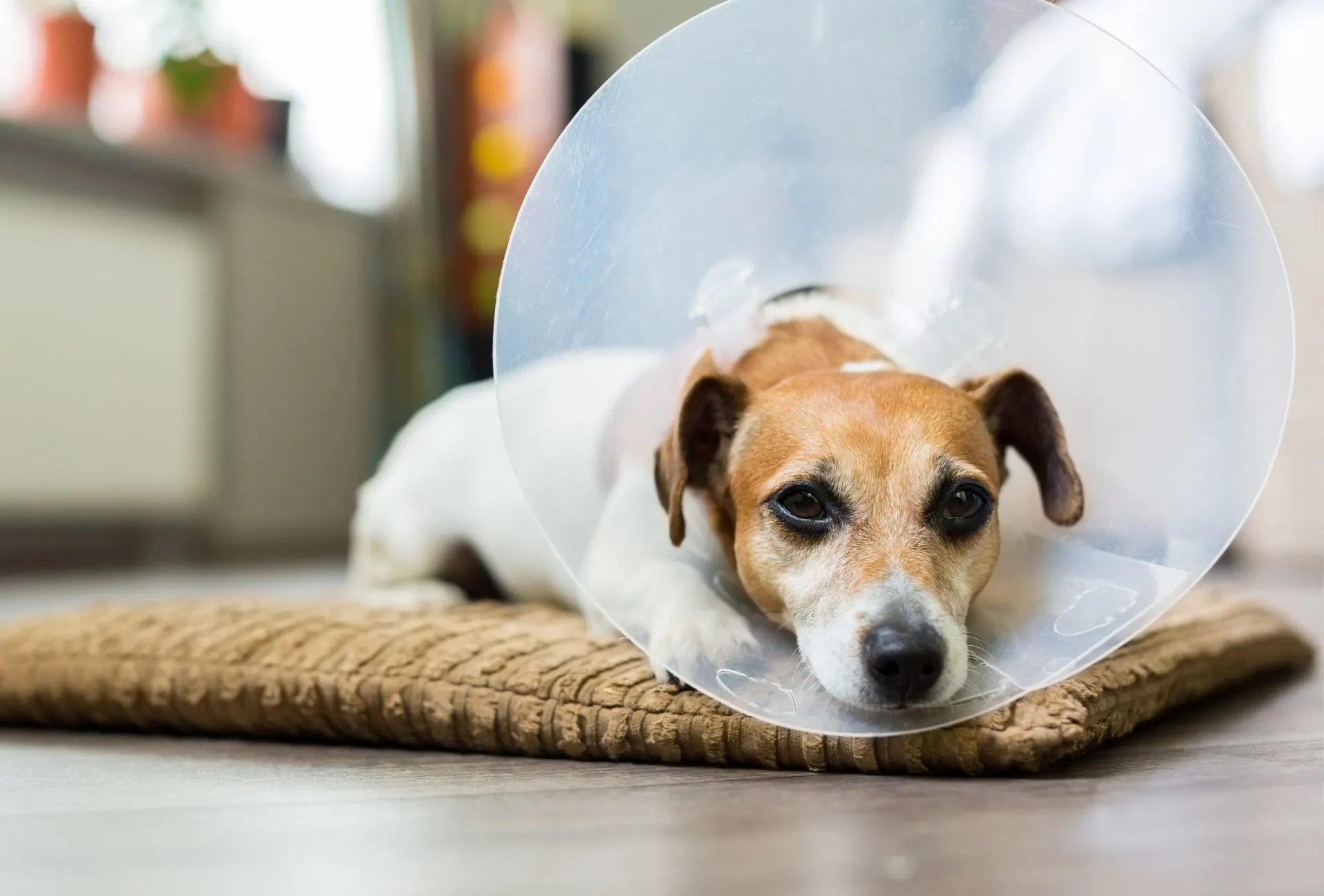Pyometra is a life-threatening infection of the uterus that requires urgent treatment.
While some dogs with mild infections may be treated with antibiotics and supportive care, this option carries risks.
Most vets will advise that surgery is performed for the best prognosis.
Of course, surgery is a big commitment and owners will naturally have many questions.
Read on to learn more about the procedure, the cost involved, the potential adverse effects and risks as well as the expected survival rate.
Pyometra Surgery Cost
Pyometra surgery may cost $500-$1,000 for simpler cases in rural areas and 1,000-$2,500 for more labor-intensive and possibly after-hours cases.
The cost of the surgery will depend on several factors.
If a dog is very unwell and needs to be stabilized and hospitalized for several days, this will bump up the invoice.
Similarly, if there are any complications or recovery takes longer than expected, the additional time spent hospitalized will add many hundreds to the final bill.
Delaying or putting off the surgery due to the cost is not really an option.
Without prompt care, the female can quickly pass away.
Also, costs will mount the more unwell your dog is when she presents at the clinic.
While a non-surgical treatment plan would cost a lot less, it has a variable success rate.
Vets can administer drugs such as Prostaglandin and antibiotics, as well as provide supportive care.
Those with a non-draining ‘closed’ pyometra are less likely to respond to medical management and success rates are as low as 25% (more on the success rate below).
If medical therapy does not work, surgery will be inevitable and your final bill will end up being more.

For owners who are very cost-concerned, there may be options to consider.
They should discuss their financial state with the vet who should try and work with them.
There may be an option of referral to a charity, the use of a payment plan, or payment under a credit scheme.
The total bill varies depending on where you live and the standard of care received.
For example, a clinic that provides 24-hour monitoring and care can be costly.
Preventing pyometra by spaying your dog before it occurs is the most cost-effective option.
However, spaying can carry risks too especially in young, senior, or sick dogs.
So in short, these circumstances will bump up your pyometra surgery invoice:
- Vet services in cities are often more expensive (partly due to more sophisticated equipment)
- After-hours services are performed at a premium
- Worst-case requires stabilization and hospitalization
- Cheaper medication-only attempts might only add to the final bill
Pyometra Surgery Survival Rate
Sadly, not every dog will pull through a pyometra surgery and the survival rate ranges from 90 to 95% with seniors or previously ill dogs being less likely to survive.
According to CTVSH, the chances of treating pyometra with the medication approach drop to 75-90% for open-cervix pyometra and 25-40% for closed-cervix pyometra.
The sooner your female is seen and treated, the better her chance of pulling through.
If she is already at the point of dehydration, shock, and kidney failure, her prognosis is sadly very poor.
Those dogs who are very elderly or who have other medical issues such as kidney disease or heart disease are less likely to survive an operation.
For example, a female who also has advanced mammary cancer and heart failure is unlikely to be a good surgical candidate and you may discuss other options with your vet.
Survival rates of the surgery depend on which studies you read but are usually quoted at about 90% to 95% in those who receive timely treatment.
Sadly, this means that at least 1 in 20 females affected will pass away.
A female can pass away before surgery if the infection is advanced.
Death during surgery can also occur due to circulatory shock or bleeding that cannot be controlled.
Female dogs can also die during the recovery period, especially within the first few days.
A pyometra surgery is less likely to go according to plan when compared to a regular neutering surgery.
Side Effects After Pyometra Surgery
Side effects after pyometra surgery include possible anesthesia reactions, infections, hemorrhage as well as bruising, swelling, and pain.
The surgery for pyometra is an ovariohysterectomy; a procedure whereby the ovaries and uterus are removed.
Though this is the same surgery carried out when a dog is spayed, it is much more of a serious and dangerous surgery when the uterus is infected.
Unlike in a healthy female, an infected uterus is full of pus and has an ample blood supply.
The risk of complications is far greater.
There is a real risk of hemorrhage, both during and after surgery.
Similarly, the risk of the infection spreading is high and many females will go on to develop septic peritonitis which can be life-threatening.
Vets will attempt to minimize side effects and improve survival rates by using good surgical techniques and providing intravenous fluids, antibiotics, and strong pain relief.
Your dog will be closely monitored in the hospital while she recovers and the veterinary team should be on the lookout for any worrying side effects such as a spike in body temperature or discharge from her abdominal wound.
Since it’s a big surgery, your female will have a large wound on her abdomen as she heals.
An infected uterus cannot be removed laparoscopically, as can be done with a healthy uterus.
As is true after any surgery, the breathing tube can cause a mild cough for several days.
Your dog will be sleepier than usual and may also be a little nauseous.
How Long Does It Take a Dog To Recover From Pyometra Surgery?
Total recovery time from a pyometra surgery will take several weeks.
For most, the recovery period will be a minimum of one to two weeks.
This period will be even longer in those who were very unwell when admitted and in geriatric females who will take longer to heal.
When discharged from the hospital, your vet will discuss how you will need to rest your female strictly and limit her exercise.
A buster collar will likely be issued, to prevent any licking or chewing of the wound.
It is important to bring your dog for her regular check-ups and most will have their sutures removed after 10 days.

It’s expected to see some vaginal discharge in the days following the surgery.
You can keep the area clean by using moist cotton wool to gently bathe the area on a regular basis.
Finish the course of any medication prescribed.
Most are given a minimum of 5 days’ worth of antibiotics, pain relief, and anti-inflammatories.
Stopping these medicines early, unless told to do so by the vet, is not advised.
If you feel your dog’s recovery is not going as smoothly as hoped and she remains lethargic or unwell, schedule a re-visit.
The vet may want to check her for complications such as an abdominal infection or kidney disease.
How Long Can a Dog Live With Pyometra?
Pyometra is a serious issue and you should not delay seeking treatment for your female, not to mention that your dog might not live long with a serious pyometra case (consult your vet on this).
Realistically, as soon it’s suspected a dog has pyometra, treatment should be initiated.
Supportive care is provided until the patient is stable and then surgery should be performed.
The longer the infection is present within the uterus and not addressed, the greater the risk of the infection spreading and the female becoming even more unwell.
Though some dogs will survive for weeks with a mild, grumbling infection, this isn’t commonly the case.
The majority of dogs suffering from this become unwell quickly once the infection has been established.
A pyometra is a true emergency and a vet should be contacted immediately if you suspect your female is affected.
This is true whether it is 3 a.m. at night or early on a Sunday morning.
The sooner your dog gets the right treatment, the more likely she is to make a full recovery.
If your dog has a closed pyometra that has ruptured, they may pass away very quickly after, within a day or two.
It can be harder to diagnose a closed pyometra as there is no visible pus.
This is why getting a diagnosis quickly is especially important.
There is no real way of predicting how long any dog can live with a uterus infection.
It depends on the health of the dog, the extent of the infection, and whether it is an open or closed pyometra.
The Bottom Line
A pyometra surgery is a life-saving procedure that needs to be performed urgently.
As patients often require diagnostic tests and a few days of hospitalization, treatment does not come cheap.
With a survival rate of about 90% to 95%, the surgery makes sense for most.
After surgery, dogs may be in some discomfort and it can take a few weeks for them to get back to fighting fitness.
The sooner we have their infection treated, the quicker their recovery.
Disclaimer: This blog post does not substitute veterinary attention and does not intend to do so. I am not a veterinarian or pet nutritionist. If your dog shows any sign of illness, call your vet.
Krista
Thursday 24th of November 2022
My dog just had surgery she is out of it. How long does this last
Danielle
Thursday 24th of November 2022
Hi Krista, your dog's recovery depends on a lot of factors but if you follow your vet's instructions regarding activity and care, etc., then you will likely notice improvement after a couple of days but total recovery process may last weeks or even more. Consult your vet if you notice physical or behavioral changes.